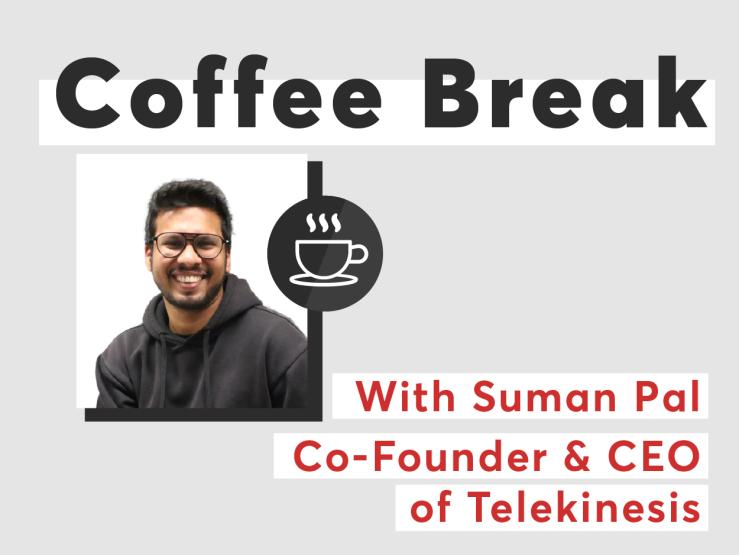Behind the groundbreaking innovation of every EIC project lies a story worth telling. In this edition of our Coffee Break series, we sat down with the founder of Telekinesis – an ambitious start-up bringing the power of AI to the world of robotics. Our conversation took place during the EIC Summit 2025, where Telekinesis had the chance to showcase its services at the Project exhibition.
Reading the interview, you will have the opportunity to explore how support from the EIC Transition programme helped turn years of academic research into a cutting-edge robotics platform. It was also the perfect moment to celebrate a major milestone for the team: being named a finalist for the prestigious euRobotics Tech Transfer Award.
For starters, could you tell us how Telekinesis' dream of developing the world's leading AI-powered robotics platform first emerged?
The story begins in the Intelligent Autonomous Systems course at the Technische Universität Darmstadt, which is led by Professor Jan Peters. For the last 20 years, he has been leading the domain of robot learning, which is the technical term for AI-powered robotics.
He's built some of the biggest breakthroughs in technology in this sector. I had completed my master's thesis with him at that point, and I was a bit of an arrogant kid.
I reached out to him and said that for the last 20 years we've built great technology across the world and industries should start using it. In this regard, I asked him why he had not offered me a PhD position, so that I could build a spin-off.
The response was: ‘You don't need a PhD to do a start-up, I would recommend you go for it now.’ And this was actually the best advice I've received.
Because from there, we started to build the technology, commercialize the breakthroughs of AI, and bring it into a singular platform. Subsequently, the EIC transition supported us in putting together one of the best robotics, AI, and computer visual teams in the world. We successfully did the spin off from the university, and now we are bringing all the last 20 years of breakthroughs in AI for robotics into the real world.
In March 2025, your team achieved a significant milestone: being selected as one of the finalists of the prestigious euRobotics Tech Transfer Award. In which way do you think the EIC Transition grant helped your team reach such an achievement?
The EIC Transition Fund was one of the most pivotal grants. Our goal was to found the spin-off we created from the university, and actually the investment allowed us to hire some of the best minds: our head of robotics has a GPA (grade point average) of 10 out of 10 in controls and automation and was hired via the EIC Transition Grant. Also, our CTO was hired via the funding we received. In a nutshell, this allowed us to put together a team that permitted us to reach relevant milestones in the area of physical AI.
This was what got us to one of the next big milestones afterwards: being selected as a finalist of the prestigious euRobotics Tech Transfer Award. Of course, we got also other milestones such as completing the spin-off, setting the Venture Capitalist round, and the technology level we achieved.
While harnessing AI allows the workforce to shift to higher-skilled, more rewarding tasks, a recent Eurobarometer survey revealed that just 62% of Europeans view robots and AI positively at work. What would you tell the remaining 38% in order to change their perceptions?
To change their perception, I would like to tell a story, focused on Hanna, an operator who had to implement one of our robotics technologies in her daily routine.
In fact, she was working at one of our first customer sites, and her job was characterised by manual tasks. As she had to work a lot, our project wanted to introduce physical AI-powered robots to help her in delivering the same task.
The first day that Hanna tried our software, she was not happy about it. She did not understand why she needed a robot. But then with only three clicks, she was able to get the robot working and complete her task. When she came in on the second day, she didn't complain, but she was still a bit grumpy.
She still had to click those three buttons, and she got the robot to work. By the third day, she was happy, she understood the way to deploy the robot correctly.
This example demonstrates that, especially in many of the manufacturing companies, there is a fear that robots could take jobs away. But what we saw with Hanna, and also in many other business cases, these robots actually help both the company and the operator to be more productive, making the lives of the latter easier.
Let's conclude on a more personal note. As AI and robots are often correlated to the sci-fi world, have you read any book or watched any movie that has inspired you particularly in your work or everyday life?
There is one impactful movie called WALL-E, by Disney Pixar. I really enjoyed the robots and their function there. They were very well designed, showing a nice world where robots well-accepted. I hope we can soon move into a world where robots are well-accepted.
About Telekinesis
Telekinesis offers AI-powered automation cells powered by Brainwave for metal manufacturing – designed to handle the most complex tasks. Achieve up to 70% operational cost savings and ROI within 12–18 months, with robots easily operated by your factory workers.

DISCLAIMER: This information is provided in the interest of knowledge sharing and should not be interpreted as the official view of the European Commission, or any other organisation.

